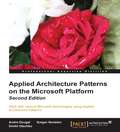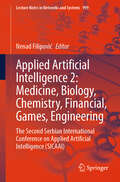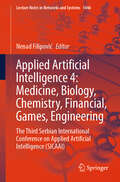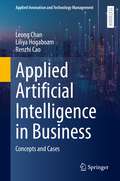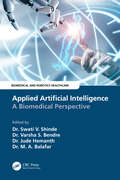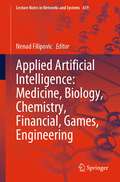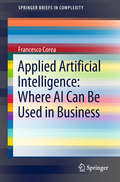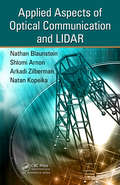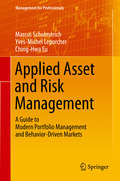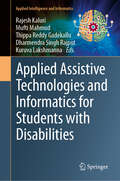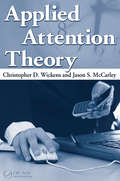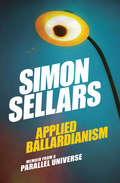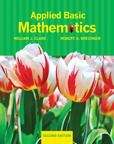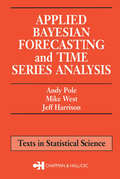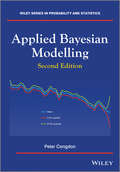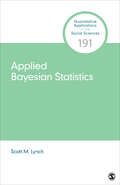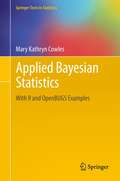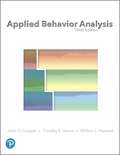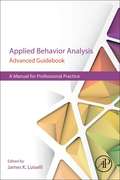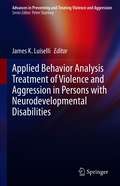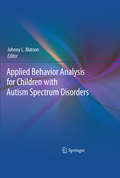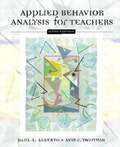- Table View
- List View
Applied Architecture Patterns on the Microsoft Platform
by Mike Sexton Richard Seroter Rama Ramani Stephen W. Thomas Ewan FairweatherThe book consists of a set of business scenarios and corresponding solution critiques. Each "use case" chapter is made up of a problem description, assessment of implementation options, and the selection of the ideal solution candidate. We then construct the solution using the chosen Microsoft technology.This book is for architects, developers, and managers who need to improve their knowledge of the Microsoft application platform. This book will appeal to anyone who wants to get up to speed on selecting the most appropriate platform for a particular problem. Consultants and executive leadership will also find significant value in this book. A good understanding of the general Windows platform and development technologies would be helpful.
Applied Architecture Patterns on the Microsoft Platform Second Edition
by Dmitri Olechko Gregor Noriskin Andre DovgalPresented in a scenario-driven tutorial way, we lead you through fictitious example problems and present you with the best solutions. This book is intended for architects, developers, and managers who need to improve their knowledge of the Microsoft application platform. This book will appeal to anyone, especially consultants, who want to get up to speed on selecting the most appropriate platform for a particular problem. A good understanding of the general Windows platform and development technologies would be helpful.
Applied Artificial Intelligence 2: The Second Serbian International Conference on Applied Artificial Intelligence (SICAAI) (Lecture Notes in Networks and Systems #999)
by Nenad FilipovićThe book Applied Artificial Intelligence 2: Medicine, Biology, Chemistry, Financial, Games, Engineering is providing exceptional chapters of the state-of-the-art research knowledge and results on the innovative theories, methodology and applications of artificial intelligence and its sub-domain like deep learning, machine learning in different areas such as medicine, economy, education, law, smart city, government, industry etc. Innovative research ideas on how to solve problems using artificial intelligence, both in R&D and real-time applications are presented. Chapters describe the advanced prototypes, systems, methodologies, tools and techniques and general survey papers, which indicate future directions. These Chapters are extended papers from the Second Serbian International Conference on Applied Artificial Intelligence (SICAAI), which was held in Kragujevac, Serbia, on May 19-20, 2023
Applied Artificial Intelligence 4: The Third Serbian International Conference on Applied Artificial Intelligence (SICAAI) (Lecture Notes in Networks and Systems #1446)
by Nenad FilipovićThe book covers the state-of-the-art research knowledge and results on the innovative theories, methodology and applications of artificial intelligence and its sub-domain like deep learning in different areas such as medicine, economy, education, law, smart city, government, industry etc. Moreover, the book aims to provide a platform for researchers and practitioners for both academia and industry to share the information about cutting-edge developments in the field of artificial intelligence. The chapters in this book integrated approach toward global exchange of information on technological advances, scientific innovations and the effectiveness of various regulatory programs toward AI application in medicine, biology, chemistry, financial, games, law and engineering. Real examples from academia and industry give beyond state of the art for application of AI in different areas. These chapters are extended papers from the Third Serbian International Conference on Applied Artificial Intelligence (SICAAI), which was held in Kragujevac, Serbia, on May 23–24, 2024.
Applied Artificial Intelligence in Business: Concepts and Cases (Applied Innovation and Technology Management)
by Liliya Hogaboam Leong Chan Renzhi CaoThis book offers students an introduction to the concepts of big data and artificial intelligence (AI) and their applications in the business world. It answers questions such as what are the main concepts of artificial intelligence and big data? What applications for artificial intelligence and big data analytics are used in the business field? It offers application-oriented overviews and cases from different sectors and fields to help readers discover and gain useful insights. Each chapter features discussion questions and summaries. To assist professors in teaching, the book supplementary materials will include answers to questions, and presentation slides.
Applied Artificial Intelligence: A Biomedical Perspective (Biomedical and Robotics Healthcare)
by Jude Hemanth Swati V. Shinde Varsha S. Bendre M. A. BalafarThis book explores the advancements and future challenges in biomedical application developments using breakthrough technologies like Artificial Intelligence (AI), Internet of Things (IoT), and Signal Processing. It will also contribute to biosensors and secure systems,and related research. Applied Artificial Intelligence: A Biomedical Perspective begins by detailing recent trends and challenges of applied artificial intelligence in biomedical systems.Part I of the book presents the technological background of the book in terms of applied artificial intelligence in the biomedical domain. Part II demonstrates the recent advancements in automated medical image analysis that have opened ample research opportunities in the applications of deep learning to different diseases. Part III focuses on the use of cyberphysical systems that facilitates computing anywhere by using medical IoT and biosensors and the numerous applications of this technology in the healthcare domain. Part IV describes the different signal processing applications in the healthcare domain. It also includes the prediction of some human diseases based on the inputs in signal format. Part V highlights the scope and applications of biosensors and security aspects of biomedical images.The book will be beneficial to the researchers, industry persons, faculty, and students working in biomedical applications of computer science and electronics engineering. It will also be a useful resource for teaching courses like AI/ML, medical IoT, signal processing, biomedical engineering, and medical image analysis.
Applied Artificial Intelligence: Medicine, Biology, Chemistry, Financial, Games, Engineering (Lecture Notes in Networks and Systems #659)
by Nenad FilipovicThe book is covering knowledge and results in theory, methodology, and applications of artificial intelligence and machine learning in academia and industry. Nowadays, artificial intelligence has been used in every company where intelligence elements are embedded inside sensors, devices, machines, computers and networks. The chapters in this book integrated approach toward global exchange of information on technological advances, scientific innovations, and the effectiveness of various regulatory programs toward AI application in medicine, biology, chemistry, financial, games, law, and engineering. Readers can find AI application in industrial workplace safety, manufacturing systems, medical imaging, biomedical engineering application, different computational paradigm, COVID-19, liver tracking, drug delivery system, and cost-effectiveness analysis. Real examples from academia and industry give beyond state of the art for application of AI and ML in different areas. These chapters are extended papers from the First Serbian International Conference on Applied Artificial Intelligence (SICAAI), which was held in Kragujevac, Serbia, on May 19–20, 2022.
Applied Artificial Intelligence: Where AI Can Be Used In Business (Springerbriefs In Complexity Ser.)
by Francesco CoreaThis book deals with artificial intelligence (AI) and its several applications. It is not an organic text that should be read from the first page onwards, but rather a collection of articles that can be read at will (or at need). The idea of this work is indeed to provide some food for thoughts on how AI is impacting few verticals (insurance and financial services), affecting horizontal and technical applications (speech recognition and blockchain), and changing organizational structures (introducing new figures or dealing with ethical issues). <P><P> The structure of the chapter is very similar, so I hope the reader won’t find difficulties in establishing comparisons or understanding the differences between specific problems AI is being used for. The first chapter of the book is indeed showing the potential and the achievements of new AI techniques in the speech recognition domain, touching upon the topics of bots and conversational interfaces. The second and thirds chapter tackle instead verticals that are historically data-intensive but not data-driven, i.e., the financial sector and the insurance one. The following part of the book is the more technical one (and probably the most innovative), because looks at AI and its intersection with another exponential technology, namely the blockchain. Finally, the last chapters are instead more operative, because they concern new figures to be hired regardless of the organization or the sector, and ethical and moral issues related to the creation and implementation of new type of algorithms.
Applied Aspects of Optical Communication and LIDAR
by Nathan Blaunstein Shlomi Arnon Natan Kopeika Arkadi ZilbermanExploring the practical aspects of atmospheric optical communication and light detection and ranging (LIDAR), Applied Aspects of Optical Communication and LIDAR details the role of atmospheric structures in propagation phenomena that influence the transmission of optical signals through perturbed atmospheric communication channels. It examines nume
Applied Asset and Risk Management: A Guide to Modern Portfolio Management and Behavior-Driven Markets (Management for Professionals)
by Marcus Schulmerich Yves-Michel Leporcher Ching-Hwa EuThis book is a guide to asset and risk management from a practical point of view. It is centered around two questions triggered by the global events on the stock markets since the middle of the last decade: - Why do crashes happen when in theory they should not? - How do investors deal with such crises in terms of their risk measurement and management and as a consequence, what are the implications for the chosen investment strategies? The book presents and discusses two different approaches to finance and investing, i. e. , modern portfolio theory and behavioral finance, and provides an overview of stock market anomalies and historical crashes. It is intended to serve as a comprehensive introduction to asset and risk management for bachelor's and master's students in this field as well as for young professionals in the asset management industry. A key part of this book is the exercises to further demonstrate the concepts presented with examples and a step-by-step business case. An Excel file with the calculations and solutions for all 17 examples as well as all business case calculations can be downloaded at extras. springer. com.
Applied Assistive Technologies and Informatics for Students with Disabilities (Applied Intelligence and Informatics)
by Mufti Mahmud Rajesh Kaluri Thippa Reddy Gadekallu Dharmendra Singh Rajput Kuruva LakshmannaThe book “Applied Assistive Technologies and Informatics for Students with Disabilities” provides a comprehensive guide to assist students with learning disabilities in higher education via modern assistive technologies and informatics. This book will take us on a tour of the various modern assistive technologies, such as artificial intelligence (AI), blockchain, computer vision (CV), text analytics (TA), the metaverse, human-computer interaction (HCI), digital twins (DT), and federated learning (FL), and how they support higher education students with learning disabilities. This book is intended for students with learning disabilities, scientists and researchers, lecturers and teachers, academic and corporate libraries, practitioners, and professionals who are interested in providing inclusive education to students with learning disabilities through the application of modern assistive technologies and informatics. This book is ideal for readers who are new to the subject and knowledgeable about the principles of inclusive education. In addition, it is a fantastic resource for teachers and parents assisting students with learning disabilities. This book can be a powerful tool to educate more students about learning disabilities, which can help eradicate the bullying of these students.
Applied Attention Theory
by Christopher D. Wickens Jason S. McCarleyEye witness testimony, training, driving, and display design: these are just a few of the real-world domains in which depend on undivided attention. Emphasizing the link between theory and application, Applied Attention Theory provides a deep understanding of how theories of attention, developed from laboratory-based psychological research, can inform our understanding of everyday human performance in a wide number of applications and environments. The basic theories discussed concern divided, focused, and selective attention, and areas of application include mental workload measurement, multi-tasking, distracted driving, complex display design, education, and the training of attentional skills. Includes an extensive reference list and citations to both basic and applied work Provides intuitive descriptions of attentional phenomena in the world beyond the laboratory Discusses applications of attention theory to diverse areas such as graph design, distracted driving, and process control Offers an engineering orientation as well as a psychological orientation to research Highlights the critical role of effort in single task behavior, such as decision and choice, to the extent that humans tend to be effort-conserving in their choice of activities Examines how multiple tasks are managed in a discrete fashion
Applied Attention Theory
by Christopher D. Wickens Jason S. McCarley Robert S. GutzwillerApplied Attention Theory, Second Edition provides details concerning the relevance of all aspects of attention to the world beyond the laboratory. Topic application areas include the design of warning systems to capture attention; attention distractions in the workplace; failures of dividing attention while driving; and the measurement of mental workload while flying. This new edition discusses the implications of VR and AR for human attention. It also covers the treatment of attention-based pedagogical methods used to enhance learning and presents attentional issues in interacting with automation and AI. New chapters include applications of attention to healthcare, education pedagogy, highway safety, and human interaction with autonomous vehicles and other AI systems. The readership for this book is the professional, the researcher, and the student.
Applied Ballardianism: Memoir from a Parallel Universe (Urbanomic / K-Pulp #1)
by Simon SellarsAn existential odyssey weaving together lived experience and theoretical insight, this startling autobiographical hyperfiction surveys and dissects a world where everything connects and global technological delirium is the norm.The mediascapes of late capitalism reconfigure erotic responses and trigger primal aggression; under constant surveillance, we occupy simulations of ourselves, private estates on a hyperconnected globe; fictions reprogram reality, memories are rewritten by the future…Fleeing the excesses of 1990s cyberculture, a young researcher sets out to systematically analyse the obsessively reiterated themes of a writer who prophesied the disorienting future we now inhabit. The story of his failure is as disturbingly psychotropic as those of his magus—J.G. Ballard, prophet of the post-postmodern, voluptuary of the car crash, surgeon of the pathological virtualities pulsing beneath the surface of reality.Plagued by obsessive fears, defeated by the tedium of academia, yet still certain that everything connects to Ballard, his academic thesis collapses into a series of delirious travelogues, deranged speculations and tormented meditations on time, memory, and loss. Abandoning literary interpretation and renouncing all scholarly distance, he finally accepts the deep assignment that has run throughout his entire life, and embarks on a rogue fieldwork project: Applied Ballardianism, a new discipline and a new ideal for living. Only the darkest impulses, the most morbid obsessions, and the most apocalyptic paranoia can uncover the technological mutations of inner space.An existential odyssey inextricably weaving together lived experience and theoretical insight, this startling autobiographical hyperfiction surveys and dissects a world where everything connects and global technological delirium is the norm—a world become unmistakably Ballardian.
Applied Basic Mathematics
by William Clark Robert A. BrechnerWith an emphasis on real world applications, Applied Basic Mathematics, Second Edition, provides students with a new and refreshing perspective on basic math. Paired with a system of structured support, authors Clark and Brechner consistently asks student to relate, reinforce, and review as they learn. This text provides professors with a dynamic way of teaching the material and an approach that encourages students to dive into the math!
Applied Bayesian Forecasting and Time Series Analysis
by Andy Pole Mike West Jeff HarrisonPractical in its approach, Applied Bayesian Forecasting and Time Series Analysis provides the theories, methods, and tools necessary for forecasting and the analysis of time series. The authors unify the concepts, model forms, and modeling requirements within the framework of the dynamic linear mode (DLM). They include a complete theoretical development of the DLM and illustrate each step with analysis of time series data. Using real data sets the authors: Explore diverse aspects of time series, including how to identify, structure, explain observed behavior, model structures and behaviors, and interpret analyses to make informed forecasts Illustrate concepts such as component decomposition, fundamental model forms including trends and cycles, and practical modeling requirements for routine change and unusual events Conduct all analyses in the BATS computer programs, furnishing online that program and the more than 50 data sets used in the text The result is a clear presentation of the Bayesian paradigm: quantified subjective judgements derived from selected models applied to time series observations. Accessible to undergraduates, this unique volume also offers complete guidelines valuable to researchers, practitioners, and advanced students in statistics, operations research, and engineering.
Applied Bayesian Modelling
by Peter CongdonThis book provides an accessible approach to Bayesian computing and data analysis, with an emphasis on the interpretation of real data sets. Following in the tradition of the successful first edition, this book aims to make a wide range of statistical modeling applications accessible using tested code that can be readily adapted to the reader's own applications. The second edition has been thoroughly reworked and updated to take account of advances in the field. A new set of worked examples is included. The novel aspect of the first edition was the coverage of statistical modeling using WinBUGS and OPENBUGS. This feature continues in the new edition along with examples using R to broaden appeal and for completeness of coverage.
Applied Bayesian Statistics (Quantitative Applications in the Social Sciences)
by Scott M. LynchBayesian statistical analyses have become increasingly common over the last two decades. The rapid increase in computing power that facilitated their implementation coincided with major changes in the research interests of, and data availability for, social scientists. Specifically, the last two decades have seen an increase in the availability of panel data sets, other hierarchically structured data sets including spatially organized data, along with interests in life course processes and the influence of context on individual behavior and outcomes. The Bayesian approach to statistics is well-suited for these types of data and research questions. Applied Bayesian Statistics is an introduction to these methods that is geared toward social scientists. Author Scott M. Lynch makes the material accessible by emphasizing application more than theory, explaining the math in a step-by-step fashion, and demonstrating the Bayesian approach in analyses of U.S. political trends drawing on data from the General Social Survey.
Applied Bayesian Statistics (Quantitative Applications in the Social Sciences)
by Scott M. LynchBayesian statistical analyses have become increasingly common over the last two decades. The rapid increase in computing power that facilitated their implementation coincided with major changes in the research interests of, and data availability for, social scientists. Specifically, the last two decades have seen an increase in the availability of panel data sets, other hierarchically structured data sets including spatially organized data, along with interests in life course processes and the influence of context on individual behavior and outcomes. The Bayesian approach to statistics is well-suited for these types of data and research questions. Applied Bayesian Statistics is an introduction to these methods that is geared toward social scientists. Author Scott M. Lynch makes the material accessible by emphasizing application more than theory, explaining the math in a step-by-step fashion, and demonstrating the Bayesian approach in analyses of U.S. political trends drawing on data from the General Social Survey.
Applied Bayesian Statistics: With R and OpenBUGS Examples (Springer Texts in Statistics #98)
by Mary Kathryn CowlesThis book is based on over a dozen years teaching a Bayesian Statistics course. The material presented here has been used by students of different levels and disciplines, including advanced undergraduates studying Mathematics and Statistics and students in graduate programs in Statistics, Biostatistics, Engineering, Economics, Marketing, Pharmacy, and Psychology. The goal of the book is to impart the basics of designing and carrying out Bayesian analyses, and interpreting and communicating the results. In addition, readers will learn to use the predominant software for Bayesian model-fitting, R and OpenBUGS. The practical approach this book takes will help students of all levels to build understanding of the concepts and procedures required to answer real questions by performing Bayesian analysis of real data. Topics covered include comparing and contrasting Bayesian and classical methods, specifying hierarchical models, and assessing Markov chain Monte Carlo output. Kate Cowles taught Suzuki piano for many years before going to graduate school in Biostatistics. Her research areas are Bayesian and computational statistics, with application to environmental science. She is on the faculty of Statistics at The University of Iowa.
Applied Behavior Analysis
by William L. Heward John O. Cooper Timothy E. HeronThis text provides an accurate, comprehensive, and contemporary description of applied behavior analysis in order to help readers acquire fundamental knowledge and skills. Applied Behavior Analysis provides a comprehensive, in-depth discussion of the field, offering a complete description of the principles and procedures for changing and analyzing socially important behavior. The 3rd Edition features coverage of advances in all three interrelated domains of the sciences of behavior–theoretical, basic research, and applied research–and two new chapters, Equivalence-based Instruction (Ch. 19) and Engineering Emergent Learning with Nonequivalence Relations (Ch. 20). It also includes updated and new content on topics such as negative reinforcement (Ch. 12), motivation (Ch. 16), verbal behavior (Ch. 18), functional behavioral assessment (Ch. 27), and ethics (Ch. 31).
Applied Behavior Analysis Advanced Guidebook: A Manual for Professional Practice
by James K. LuiselliThe Applied Behavior Analysis Practice Guidebook: A Manual for Professional Practice gives behavioral practitioners pragmatic advice, direction and recommendations for being an effective clinician, consultant, supervisor and performance manager. The book adopts a how to do it perspective featuring contributions from expert scientist-practitioners. Each chapter introduces the relevance of the topic for practicing professionals, describes and synthesizes the empirical basis of the topic, and then presents practitioner recommendations. With this format, readers can navigate the chapters with familiarity and confidence to facilitate the understanding of content and integration of the many practice areas addressed.
Applied Behavior Analysis Treatment of Violence and Aggression in Persons with Neurodevelopmental Disabilities (Advances in Preventing and Treating Violence and Aggression)
by James K. LuiselliThis book focuses on applied behavior analysis (ABA) treatment of violence and aggression in persons with neurodevelopmental disabilities. It details ABA theory and concepts leading to empirical treatment procedures that can be implemented successfully across diverse treatment settings. Further, the book examines contemporary approaches to functional behavioral assessment (FBA) and functional analysis (FA) in determining the environmental conditions responsible for violence and aggression. In addition, the volume describes several evidence-supported treatment procedures that encompass antecedent-control, contingency management, cognitive-behavior therapy, and physical intervention components. It addresses effective strategies for training and supervising care providers, including behavioral skills training (BST), posttraining performance management, and mindfulness. Finally, the book presents recommendations that guide effective and socially valid research-to-practice translation. Applied Behavior Analysis Treatment of Violence and Aggression in Persons with Neurodevelopmental Disabilities is an essential resource for researchers, clinicians/therapists, and upper-level undergraduate and graduate students in forensic psychology, public health, criminology/criminal justice, and behavioral therapy and rehabilitation.
Applied Behavior Analysis for Children with Autism Spectrum Disorders
by Johnny L. MatsonAutism was once thought of as a rare condition, until the Centers for Disease Control and Prevention's Autism and Developmental Disabilities Monitoring Network released the statistic that about 1 in every 150 eight-year-old children in various areas across the United States is afflicted by an autism spectrum disorder, or ASD. This news led to a dramatic expansion of research into autism spectrum disorders and to the emergence of applied behavior analysis (ABA) as the preferred method of treatment, even among prescribing practitioners. Applied Behavioral Analysis for Children with Autism Spectrum Disorders ably synthesizes research data and trends with best-practice interventions into a comprehensive, state-of-the-art resource. Within its chapters, leading experts review current ABA literature in depth; identify interventions most relevant to children across the autism spectrum; and discuss potential developments in these core areas: Assessment methods, from functional assessment to single case research designs. Treatment methods, including reinforcement, replacement behaviors, and other effective strategies. The role of the differential diagnosis in ABA treatment planning. Specific deficit areas: communication, social skills, stereotypies/rituals. Target behaviors, such as self-injury, aggression, adaptive and self-help problems. ASD-related training concerns, including maintenance and transition issues, and parent training programs. This volume is a vital resource for researchers, graduate students, and professionals in clinical child and school psychology as well as the related fields of education and mental health.
Applied Behavior Analysis for Teachers
by Paul A. Alberto Anne C. TroutmanThis text explains behavior theory and teaches aspiring educators how to apply it to classroom settings.

